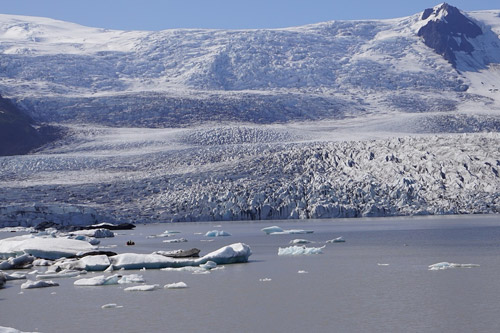With imagery and data from Landsat 8, a joint mission of NASA and the US Geological Survey, scientists, including one from the University of Bristol, are providing a near-real-time view of every large glacier and ice sheet on Earth.
The NASA-funded Global Land Ice Velocity Extraction project, called GoLIVE, is a collaboration between scientists from the University of Colorado, the University of Alaska, and NASA's Jet Propulsion Laboratory. It aims to better understand how ice flow is changing worldwide – and its impact on sea level.
Ted Scambos, senior research scientist at the National Snow and Ice Data Center at the University of Colorado Boulder, and the Colorado lead for the GoLIVE project, said: "We are now able to map how the skin of ice is moving."
He and his colleagues are releasing new results from the project at the American Geophysical Union’s Fall Meeting in San Francisco.
He added: "From now on, we’re going to be able to track all of the different types of changes in glaciers – there’s so much science to extract from the data."
With a near-real-time view of how glaciers and ice sheets are moving, researchers can integrate information about atmosphere and ocean conditions to determine what causes these ice sheets to change – and what that means for how much ice is flowing into the ocean. That could help provide critical information to coastal communities that will be most impacted by rising oceans.
Ted Scambos said: "We can use the method to identify which areas to keep an eye on, or which events might lead to a rapid change."
To map the ice, the GoLIVE team has written software that is able to follow the surface's subtle features, like bumps or a dune-like pattern, as they flow toward the ocean. The Landsat 8 satellite collects images of Earth's entire surface every 16 days. By comparing images taken from the same location, but at different times, the researchers use their software to track the features and determine the speed.
Several new capabilities of Landsat 8 enable researchers to generate these global maps. The satellite can take 700 images a day – far more than its predecessors – which means it captures nearly every scene over land, every day, in all the sunlit parts of its orbit. Previous Landsat satellites often did not have the capacity to collect frequent data over remote sites like Antarctica. The imaging system on Landsat 8 is also far more sensitive than past Landsat sensors, allowing it to distinguish far more subtle differences in shading and surface texture. This, plus faster and more precise software, has revolutionized the extent to which ice flow speed can be mapped. These features will be continued in the Landsat 9 satellite, scheduled for launch in 2020.
Dr Twila Moon, from the School of Geographical Sciences at the University of Bristol, uses the global maps to expand the research she does on Greenland glaciers.
With the new database, she can study the movements of more than 240 glaciers, which comprise nearly all of the outlets from the ice sheet. Several glaciers in northwest Greenland have had accelerated speed in the last few years, while she saw some glaciers in the southeast experience a large jump in speed, followed by a plateau.
With Landsat 8 making a pass every 16 days, she can also measure seasonal changes.
Most glaciers go in cyclic patterns throughout the year, but even those vary. While most speed up in the warmer summer months, Dr Moon has found several that slow down dramatically in the mid- to late-summer. The Heimdal Glacier in southeast Greenland, for example, can move more than 10 metres per day (33 feet per day) in early summer, then drop to less than 6 metres per day (20 feet per day) by August or September.
She said: "We can group these glaciers by looking at the similarities in their behavior. It’s providing an opportunity to get at the underlying drivers of why they change."
With measurements of what the seasonal shifts do to glacier speed, scientists can extrapolate what will happen to those glaciers as global temperatures continue to climb, she said. With fast-moving glaciers ending in the ocean, these studies can help scientists estimate how much new ice and water enters the Arctic Ocean. That new water can have both global and local impacts, changing the local ecosystems, ocean flow patterns, and raising sea level.
Dr Moon added: "We're approaching a point where we have enough detailed information at different locations that we can start to answer important questions about what makes glaciers tick."
